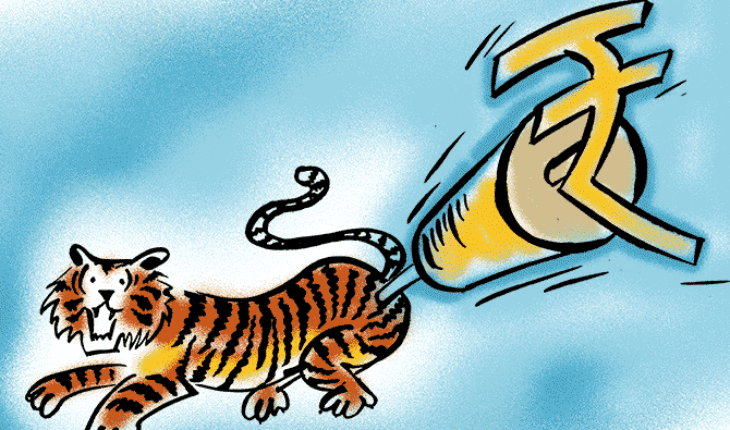
The term “Tiger Economy” is commonly used to refer to the growing economies in Southeast Asia. Countries with tiger economies include Singapore, Hong Kong, South Korea, Taiwan, etc. Export is the basis of development in such an economy, that is, such countries maintain the pace of development with the help of exports. Countries like Singapore, Hong Kong, South Korea, Taiwan etc. adopted export and free trade policies and were successful in maintaining the flow of development. Even though India has become the fifth largest economy in the world by surpassing England and now only the United States, China, Japan, and Germany have bigger economies than it, but there are other factors behind India’s growth than exports. The pace of exports in India is slowly picking up, but that is not satisfactory. The Indian market is still not fully opened to the world for business. Both public and private sector are working together in the country, but the participation of private sector is still less.
The journey of the Indian Economy since Independence
When India became independent, India’s gross domestic product (GDP) was Rs.2.7 lakh crore, which increased to Rs.135.13 lakh crore in the financial year (FY) 2020-21. The first five-year plan started in the year 1951, but it was not very successful in strengthening the economy. The subsequent five-year plans also could not yield the expected results. However, from the year 1961, growth in the Indian economy started becoming visible. From the year 1950 to the year 1979, the country’s GDP was growing at an average rate of 3.5 percent, which was called “Hindu Growth Rate” in the Indian economy, whereas from the year 1950 to the year 2020, India’s GDP growth rate was at an average rate of 6.15 percent.
The GDP reached the highest level of 11.40 percent in the first quarter of 2010, however, the corona period saw an even better GDP growth rate due to the base effect, while it recorded the lowest growth of 5.20 percent in the fourth quarter of 1979. It is noteworthy that the GDP growth rate went into minus during the pandemic. In the year 1960, India’s per capita income was US $ 81.3, which increased to US $ 7332.9 in April 2021.
The annual growth rate of per capita income in the country was 3.1 percent on an average during the financial year 1980-81 to the financial year 1991-92, which increased to an average level of 3.7 percent during the financial year 1992-93 to the financial year 2002-03, which again doubled during the financial year 2003-2004 to the level of 7.2 per year on an average during the financial year 2007-2008. In the subsequent years also, it saw a gradual increase.
Good Number of GDP Despite the Pandemic
During the December quarter of FY 2021-22, the GDP stood at 5.4 per cent and in the third and fourth quarter as well, a decrease in GDP growth rate was recorded, but overall, during FY 2021, an impressive growth of 8.7 per cent was recorded in GDP. Not only this, a significant increase in GPP was also recorded during the fourth quarter of FY 2021 and the first quarter of FY 2022, but in FY 2022 the GDP declined to 4.1 percent. Factors of reduction in GDP were pandemic, geo-political crisis, ongoing war between Russia and Ukraine, high rate of inflation etc. However, India’s GDP growth rate during this period was better than many developed countries.
Economic Reforms
From the year 1991, the Government of India started economic reforms, which is still going on today. In the year 1991, many measures were taken to bring positive changes in the areas of foreign trade, tax reforms, foreign investment etc., which helped the Indian economy to move forward. The average growth rate of GDP at factor cost during 1951 to 1991 was 4.34 percent, which increased to 6.24 percent during 1991 to 2011. The Indian economy crossed US$ 2 trillion in the year 2015 and India’s GDP is expected to grow to $3.1 trillion in the year 2021 as per the World Bank. After the process of liberalization started in the country, the private sector grew rapidly, but still the Indian economy remains mixed, that is, the private and public sectors are working together in the country. However, the private sector is still far behind in strengthening the infrastructure.
Share Market
For the first time in the eighties, the Bombay Stock Exchange (BSE) index crossed the 1000 marks in the financial year 1989-90. In the year 2006, the BSE index crossed the 10000 marks. Then it crossed 30000 marks in FY 2014-15 and 40000 marks in FY 2018-19, crossing the record 60000 marks in 2021. The Nifty index also crossed the record 18000 marks in the year 2021. In the year 2023 also, both these indices are hovering around 60000 and 18000 marks, which shows the strength of the companies listed in both the indices.
Rating Upgradation of Banks and India
Global rating agency Moody’s has upgraded the ratings of 9 Indian private and public sector banks to stable from negative outlook. The banks whose ratings have been upgraded by Moody’s include private sector Axis Bank, HDFC Bank, ICICI Bank and public sector banks include Bank of Baroda, Canara Bank, Punjab National Bank, Exim Bank and Union Bank of India. Apart from banks, Moody’s has also upgraded India’s rating from sovereign negative to stable. India’s rating is currently Baa3. The rating upgrade of India and Indian banks by Moody’s means that the risks associated with the Indian economy and Indian banks are coming down.
Mounting Exports
India’s exports in the FY 2022-23 registered a growth of 6 percent to reach the level of $ 447 billion, while in the FY 2021-22 the exports were $ 422 billion. At the same time, imports increased by 16.5 percent to $ 714 billion in the FY 2022-23, which was $ 613 billion in the FY 2021-22. Exports of goods & services are set to increase by 14 percent to $770 billion in FY 2022-23, from $676 billion in the FY 2021-22, while it was $500 billion in FY 2020. At the same time, only service exports increased by 27.16 percent to $ 323 billion in the FY 2022-23, from $ 254 billion in the FY 2021-22.
Conclusion
Today the developed countries of the world are on the verge of recession, but the Indian economy remains strong. India is in a better position than the developed countries of the world in terms of major factors of recession, GDP, unemployment, inflation etc. At present, there is an outcry due to inflation in Europe and America, including all neighboring countries of India, but inflation in India has come down to a 15-month low of 5.66 percent in March 2023. Here, the currencies of European countries have become weak against the dollar, but the position of the rupee is better than them and recently there has been a weakness seen in the dollar compared to the rupee.
It is clear from the investigation, India is still far behind in terms of exports, the main parameter of the tiger economy and the Indian market is also not fully opened to the world, due to which the current growth rate is not picking up. In such a situation, until India is not able to fully realize the concept of “Make in India”, India’s dream of becoming a tiger economy cannot come true. When India becomes self-sufficient in the matter of production of all commodities, then it will automatically get freedom from imports. Hence, in the present context it would be fair to say that the Indian economy is not going to become a tiger economy any time soon.
Satish Singh, Mumbai based Senior Journalist, Views are personal. Mobile No.8294586892






